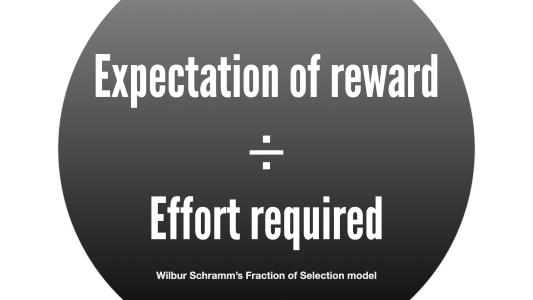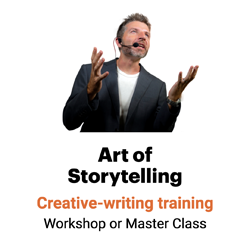Grab attention, keep it longer, communicate better & more
My crotchety neighbor likes to quote his favorite philosopher, Anonymous:

“If a man speaks in the forest, and no woman is there to hear him, is he still wrong?”
For communicators, the question is a little different. David Murray, executive director of the Professional Speechwriters Association, says:
“If nobody hears your strategic messaging, does it make a sound?”
The biggest risk in communications is not that we might offend someone with creativity or write something that’s eye-rollingly goofy. The biggest risk communicators run is that we never get heard at all.
How do we engage people and get them excited about our content? The key is to make our content more creative.
Whatever type of content you’re creating — from long-form blog posts to teeny tiny social media updates, from content marketing pieces to speeches, from web pages to white papers — you’ll create more successful content when you make it creative.
200 years of research
In the early 19th century, German philosopher Johann Friedrich Herbart said that interest leads to understanding, learning and memory — and even inspires readers to learn more.
For nearly 200 years, researchers, philosophers and communicators have seen the link between interest and learning.
One of those researchers is Suzanne Hidi, associate member at the Ontario Institute for Studies in Education’s Centre for Applied Cognitive Science. In “Interest and Its Contribution as a Mental Resource for Learning,” she presents a research review on how interest helps people learn.
Interesting copy, according to Hidi’s review of the literature:
- Encourages reading and improves comprehension (Hidi and Baird, 1986)
- Increases understanding (Bernstein, 1955)
- Aids in learning (Hidi and Baird, 1986; Shirey and Reynolds, 1988)
- Helps people remember (Hidi and Baird, 1988)
- Helps readers to come up with fuller, better and more creative responses (Bernstein, 1955)
And that, of course, will dramatically increase your business success.
Why creative content writing? Because creative content:
1. Grabs attention.
Our readers receive the data equivalent of 174 newspapers a day — ads included, according to a study by USC’s Annenberg School for Communication.

How do they sort through all of that incoming to select the tiny fraction of pieces they’ll actually read?
They ask what they’ll get out of it versus what they have to put into, according to communication theorist Wilbur Schramm’s Fraction of Selection Model. (Or “expectation of reward divided by effort required,” in Schramm’s words.)
One of the key rewards of reading is entertainment. That’s another reason a high-quality content strategy includes creative content writing.
2. Keeps attention.
Creative material also keeps attention — through the piece and over time.
“Make the important interesting.”
— James Fallows, national correspondent for The Atlantic Monthly
That’s one reason the entertaining feature-style story structure outperforms the boring inverted pyramid in study after study.
That means the communicator’s job is to “Make the important interesting,” says James Fallows, national correspondent for The Atlantic Monthly.
3. Communicates better.
Some concepts you can only explain through creative writing techniques.
“Anyone who tries to make a distinction between education and entertainment doesn’t know the first thing about either.”
— Marshall McLuhan, communication theorist
For instance, former surgeon general C. Everett Koop once compared a sophisticated technique for correcting an undeveloped esophagus to “threading together two wet noodles in the bottom of an ice cream cone with your eyes closed.”
That’s a concept you can only communicate to a lay audience by using the creative technique of metaphor.
4. Enhances credibility.
People are more likely to believe information if it’s presented as an anecdote than if it’s presented as a number, according to Peg Neuhauser’s Corporate Legends and Lore.
“There are three kinds of lies: lies, damned lies, and statistics.”
— Mark Twain
Why are stories more credible than statistics?
One reason is the Peer Principle of Persuasion: People connect with people. Readers find messages more readable, understandable and persuasive when you let a person stand for your point. That’s one reason human interest is so persuasive.
And why are statistics less credible than stories?
Your readers have learned not to trust every number they encounter. “There are three kinds of lies,” as Mark Twain said back in the day. “Lies, damned lies, and statistics.”
5. Lingers longer in the readers’ mind.
People are more likely to remember creative content than boring content.
One reason, according to Neuhauser: People process just plain facts in one way — intellectually, it goes through their brain. But they process the creative technique of storytelling in three ways:
- Intellectually
- Visually
- Emotionally
That’s three ways readers can tamp it into their minds … and three ways they call pull it up later, when they want to remember the story and its point.
6. Gets shared.
If you want your message to get shared, you need to give readers something worth sharing. People are likely to share humor, stories and other entertaining elements.

People are most likely to share information, according to research by Chadwick Martin Bailey:
- Because I find it interesting/entertaining (72%)
- Because I think it will be helpful to recipients (58%)
- To get a laugh (58%)
But when was the last time you had some friends over for a pitcher of your signature margaritas, and you all spent the evening batting around a few good statistics?
If you want people to share, give them something shareable.
7. Slashes burnout, improves performance.
Content writers enjoy creating content that’s entertaining more than hashing out the same, old Ws and H again and again. That means they’re more likely to stay engaged with their work when they’re flexing their writing skills.
That’s a win-win for employers as well as communicators.
8. Sells products, services, programs and ideas.
As midcentury adman David Ogilvy said:
“Nobody ever sold anybody anything by boring them to death.”
Want readers to buy your Whozit or Whatzit? Choose creative content writing.
Learn more about creative content writing.
Find out about:
- A creative process for coming up with better topic ideas and other concepts
- How to optimize creative content for search engines and real readers
- How to write with description, wordplay and other creative techniques

Leave a Reply